


Monthly Archives: November 2018
Filters
La Motte History
Images from photo archive:

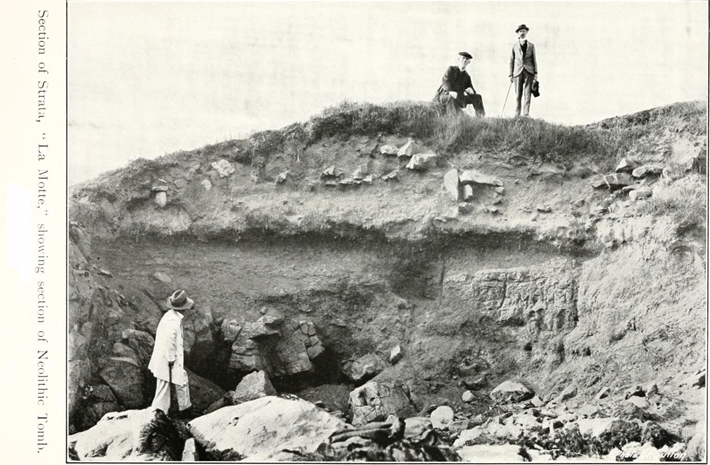
Archaeological excavations carried out between 1911 and 1914 showed that the islet had been occupied over a long period of time. Despite being quite small the site is unusual because it had several both ritual and domestic elements, as well as providing important environmental evidence relating to changes in sea level. The remains of a series of prehistoric rubbish heaps, dating between 1,500-300 BC, containing fragments of pottery, animal bones, stone tools and shells were found.
Group of 18 cists which were excavated were dated from the Bronze Age to the Iron Age. Two cists can be found at La Houge Bie.
Cist: An ancient coffin or burial chamber made from stone or a hollowed tree

La Motte is a tidal island, and listed archaeological site, also known as Green Island, located in the Vingtaine de Samarès in the parish of St Clement on the south-east coast of Jersey, Channel Islands.
The island has a grassy surface and is predominantly clay surrounded by rocks. In recent times efforts have been made to reduce erosion of the island by the construction of walls.

Some archaeological evidence has been found here. Remains of a cemetery on La Motte are believed to be from later settlers. There are Neolithic elements including a cairn and a number of middens, dating from 1500 BC to 300 BC, on La Motte.
http://photographic-archive.societe-jersiaise.org/Details/archive/110003728

To the east of Grève d’Azette beach lies Le Croc du Hurté. In the medieval period this small promentory actually extended out to what we now know as Green Island or to give it its old name, La Motte – the mound. Richard Popinjay from Portsmouth drew a map of Jersey for Queen Elizabeth I in 1563 which shows La Motte still part of the main island. At some stage in the 17th century a severe storm must have caused the waves to smash and wash away the thin strip of land connecting it to Le Croc du Hurté.
/arc-anglerfish-arc2-prod-jerseyeveningpost-mna.s3.amazonaws.com/public/BTV2F7FIYZCOJMDC3F7QT23XG4.jpg)


In September 1858 some children found a skeleton buried on the islet. The mystery was cleared up at the coroner’s inquest by 82-year old James Le Templier who said that he had discovered the body sewn in a hammock washed up on the islet about 50 years earlier. As there had been a naval engagement between a Royal Navy vessel and a French Navy brig a few days before, the Constable of St Clement declared the body to be that of a French sailor and ordered the soldiers from the Roqueberg battery to bury it on La Motte.
https://jerseyeveningpost.com/news/2009/10/23/witch-trials-in-jersey-fact-or-fiction/
https://jerseyeveningpost.com/features/2015/05/03/coast-gallery-spotlight-on-green-island/
The slipway, La Montée de la Sordonnière, was built about 1870 and takes its name from the beach – sordonnière means a sea slug.
At the far end of the beach is Rocqueberg. A guardhouse with an associated magazine was built here in 1691 from which the men of the St Clement’s militia kept a look-out in times of emergency. In the late 18th century two 24-pounder cannon were positioned here on a wooden platform behind an earth wall or boulevard.
In 1797 an accidental explosion destroyed the original guardhouse and because of financial constraints it was not replaced until 1802. By then a small detachment of the regular army was based here and it was these men who were tasked with burying the French sailor on Green Island.
Analysis of past student essay
Notes and evaluation on another book:
Anna Houiellebecq: Inside Out
Houiellebecq speaks much about the project being about capturing the physical representation of hidden emotions. Her body ‘inside out’ includes images of the subjects posing in a certain way that represent a specific emotion. Her images focus on particular areas of the body, this being hands and faces; small sections at a time. Her book also allows a creative way that allows shapes and movement to be seen throughout. It has a very contemporary feel because of the way the human body uses light and abstract visions. The variation of images spreading from the whole page to half of the page allows a portrait oriented angle of the book itself. There is no category to her images, which I enjoy as this is similar to the narrative aspect that I too am looking for in my images. To do so the images are linked in similar ways through either colour or perhaps subject.Her images have a variation of coloured and black and white as this allows a contrast within the flowing format already. She decided to choose the ‘bath images’ to go into black and white as this looked better this way as the contrast of tones work better in black and white. An aspect of her book I throughly enjoy is the use of poems about particular aspects of the body itself. And for these double pages she used a similar colour themes and aesthetic as much as possible.
I think her title is very suiting and successful when thinking about the completion of this book ‘Inside out’ came from an expression of hidden emotions in a physical embodiment of human form. Another aspect I thought was successful was how the colour throughout looked professional and clear and precise to the overall Finish of the book itself. She was very clear with the amount of research she produced when speaking about body image and exploring how body expresses hidden emotions. She released though her research how bodies are usually intertwined and inspired by daily physical contact. she decided photographing political, social and emotional groups of a person was successful. I think this is interesting as this was similar to one of my first ideas about the exploration of human emotion reflected in a landscape. However I think when considering the sublime, I might consider the emotions behind the sublime itself, This would be considering how sublime emotions are within ourselves, and we do not know others emotions or inner feelings.Her essay question is quite substantial asking ‘how and why do photographers use the human body to physically express hidden emotions’
I believe her work is full marks, her work is conceptual and allows many bodies of work to inter-twin successful into one working concept. Her essay is clear and expands onto the following topics of politics, culture, sexuality and gender issues. Her images not only show political issues but they show emotion through the smallest of areas on the body, which I think is so hard to accomplish yet she achieved this so well. I find it fascinating how she talks about how the human body can be used as a tool to express what cant be said in photography. or as a ‘physical visualisation of unheard emotions’. The way she so successfully analysis her images making sense of what is happening and what she is trying to connote, is easily understood yet also well in depth and creates an awareness to whats he is trying to achieve.
She talks about the physiology of her work, clearly expanding from just a photographers view on the subject. Her references to other artists that successfully join into her work. Her analysis is also divided into conceptual and surreal forms of looking at the body, I think this important because there are so many possible variations and ways in which you could view the art so doing a clear depiction divided in a way such as this is very clear and shows conceptual thinking. I think many of the conceptual themes of her book such as the colour scheme not only intertwine the written work to her visual but also creates a sense of mimicry within the colours symbolising the emotions she is trying to convey.she also successfully links her written work and the whole book itself to specific photographers and this essence of cohesion really helps to achieve her subject matter and her artists linked and wholly visible within her work. The Themes I would like to take out o this book are t pieces of text she uses in order to almost explain and deep then the thought of her work. I also believe how she used colour was so well thought out and received. I think her images themselves have such a strong overall theme yet and narrative yet without having to tell a chronological story which I would also like to show within my own work. Her subjectivity and images work well hand in hand and I think this piece as a whole was so well thought out ,presented and achieved and I will sue this as the basis of my own inspiration .
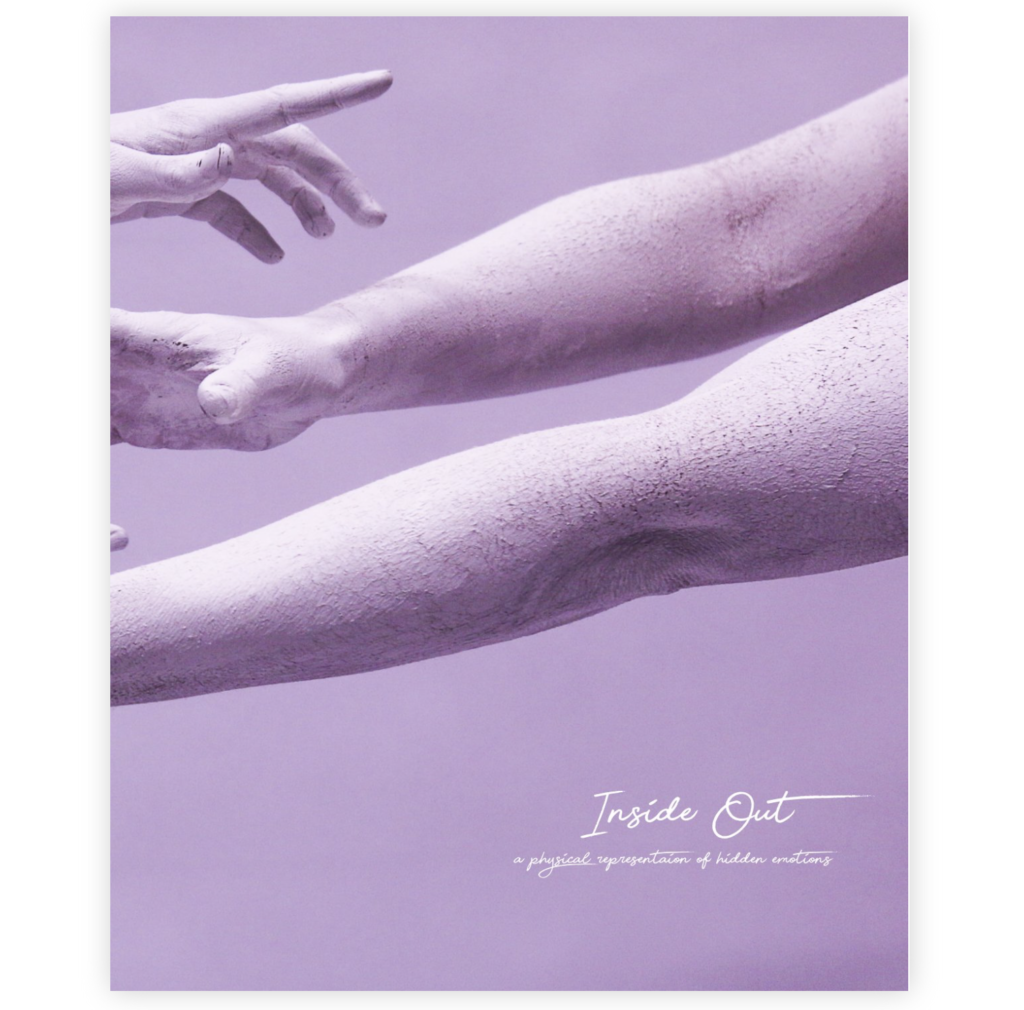
Art Movements & Isms – Pictorialism vs Realism
PICTORIALISM
Time period : 1880s-1920s
Key characteristics/ conventions :
- Pictures that resembled paintings
- Manipulating images in the darkroom
- Scratching and marking their prints
- Blurred and fuzzy imagery
- Based on allegorical and spiritual subject matter
- Pictorialism reacted against mechanization and industrialization.
Artists/Influences associated:
Allegorical Painting – Allegory is a figurative mode of representation conveying meaning other than the literal. Allegory communicates its message by means of symbolic figures, actions or symbolic representation. The underlying meaning has moral, social, religious, or political significance
Julia Margaret Cameron was a photographer in the Victorian era. Cameron’s photographs were unconventional in their intimacy and their particular visual habit of created blur through both long exposures, where the subject moved and by leaving the lens intentionally out of focus.
Emerson’s Naturalistic Photography – In 1889 Peter Henry Emerson (1856-1936) expounded his theory of Naturalistic Photography which the Pictorialist used to promote photography as an art rather than science. Their handcrafted prints were in visual opposition to the sharp b/w contrast of the commercial print
Examples of Pictorialsm photographs


Key works: Sally Mann’s loss of life project.
Drawing upon her personal experiences as inspiration, Sally Mann creates a haunting series of photographs that speaks about the one subject that affects us all, the loss of life. Dark, beautiful and revelatory, What Remains, created in 2004 is a five-part meditation on mortality, explores the ineffable divide between body and soul, life and death, spirit and earth. This body of work consist of landscape, pictures of decomposing bodies and portraits of her children which links to the pictorialism movement.
Methods/ techniques/ processes:
Using a physical method to scratch out negatives and create texture in the photographs to provide a blurred or fuzzy image. Vaseline also used to smear over the lens to provide a blurred image to replicate art of that time.
REALISM / STRAIGHT PHOTOGRAPHY
Time period: Straight photography’s time period started towards the end of the pictorial era
Key characteristics/ conventions :
- These photographers strove to make pictures the were ‘photographic’ rather than ‘painterly’.
- They abhorred handwork and soft focus and championed crisp focus with a wide depth-of-field.
- Photographs are not manipulated
- These straight approaches to photography continue to define contemporary photographs, while being the foundation for many related movements, such as Documentary, Street photography and Photojournalism
- Special relationship to reality
- Camera’s ability to record objectively the actual world as it appears
Artists associated:
Alrfred Stieglitz, Paul Strand, Walker Evans, Dorothea Lange
Examples of Work
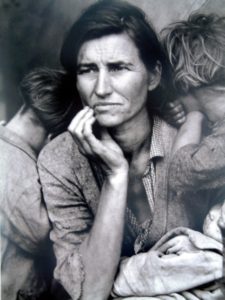

Key works:
Walker Evans (1903-75)
Often considered to the leading American documentary photographer of the 20th century. He rejected Pictorialism and wanted to establish a new photographic art based on a detached and disinterested look. He most celebrated work is his pictures of three Sharecropper families in the American South during the 1930s Depression.
Methods/ techniques/ processes:
- Taking of the image or by darkroom or digital processes
- Taking pure photos with no manipulation included
Essay Question And Plan
Essay Question:
Previous examples:
How does people control, interact and construct the environment in which they live?
How can photography bear witness to the ways of life and events of the world?
Voyeurism and the nature of observation and intervention in documentary photography.
Is it possible for photography to capture moments in time objectively and truthfully?
In what way do photographers Edwards Burtynsky and Henry J Fair present their perspectives regarding consumerism.
CHOSEN QUESTION:
In what way do photographers Edwards Burtynsky and Henry J Fair present their perspectives regarding consumerism.
Planning my essay:
Introduction.
- Introduction (250-500 words): What is your area study? Which artists will you be analyzing and why? How will you be responding to their work and essay question?
Regarding the essay question I have written and chosen, I will be looking specifically at the photographic areas of composition and using it to manipulate a perspective and opinion from viewers. The thought process behind these ideas are down to my interest in documentary photography, and how it's able to become a major factor in the influencing of people worldwide. By switching between what can be seen as conventional and unconventional photography, I found that by changing the way you portrayed specific scenes (such as abstract or realism) it would create a certain impression of the photo, placing the viewers in the same mind-set as you. What particularly attracted me to this style of photography was that by using a documentary stance I could incorporate political viewpoints underlying what is seen, thus creating a political landscape with the piece which only with an understanding of the area can be understood. Photographers that I found to be predominantly inspiring are J Henry Fair, a photographer who explores the scarring of landscapes caused by our societies every increasing consumerism, and Edward Burtynsky, a landscape photographer who captures the scarring results of industrialization through aesthetic and almost abstract imagery. What appealed to me through the works of J Henry Fair was his way approach towards scarred landscapes, using symmetry and vivid colours to portray his vision in aesthetic but devastating ways, with his main focuses consisting of industrial areas and how the area is effected. By presenting landscapes this way, it can not only influence the viewer, but also create particular feelings towards the events photographed, especially with the knowledge behind the image of why it occurred and how the use of higher saturation creates a more drastic and effective response. Edward Burtynsky however influences me with his stance on abstract documentary style photography, here Burtynsky uses symmetry and patterns to break conventions to create results that look to beautiful to be real. However his work has an underlying meaning from how all aesthetic patterns are created through the destruction of the natural environments, and thus is the result of destroying our landscape, implicitly contrasted to Fair who tends to photograph the industrial sites rather than the area around them like Burtynsky does. Overall for me this presents evidence to how the processes and outcomes to consumerism can be heavily defined by the angle of the photographer, who can choose the perspective that we take regarding the meaning and message of the photographed landscapes.
- Pg 1 (500 words): Historical/ theoretical context within art, photography and visual culture relevant to your area of study. Make links to art movements/ isms and some of the methods employed by critics and historian. Link to power points about isms and movements M:\Departments\Photography\Students\Resources\Personal Study
- Pg 2 (500 words): Analyse first artist/photographer in relation to your essay question. Present and evaluate your own images and responses.
- Pg 3 (500 words): Analyse second artist/photographer in relation to your essay question. Present and evaluate your own images and responses.
- Conclusion (250-500 words): Draw parallels, explore differences/ similarities between artists/photographers and that of your own work that you have produced
- Bibliography: List all relevant sources used
Academic Sources
Bibliography:
What is a bibliography?: A complete of selective list of workings that has been complied into some common principles such as authorship, subject, place of publication, or printer. Because of this it can be seen as source materials that are used or consulted in the preparation of a work that are referring to a text, with many branches of library science dealing with the history, physical description, comparison, and classification of books and other work. Here are some examples of bibliographies I have made:
- Rexer, L. (2013). The edge of vision. New York: Aperture Foundation, p.9.
- Disphotic. (2018). The GIF of Life: Vestigial File Formats as Documentary. [online] Available at: http://www.disphotic.com/the-gif-of-life-vestigial-file-formats-as-documentary/ [Accessed 22 Nov. 2018].
Below is a annotated diagram of a bibliography I will be using in my essay: 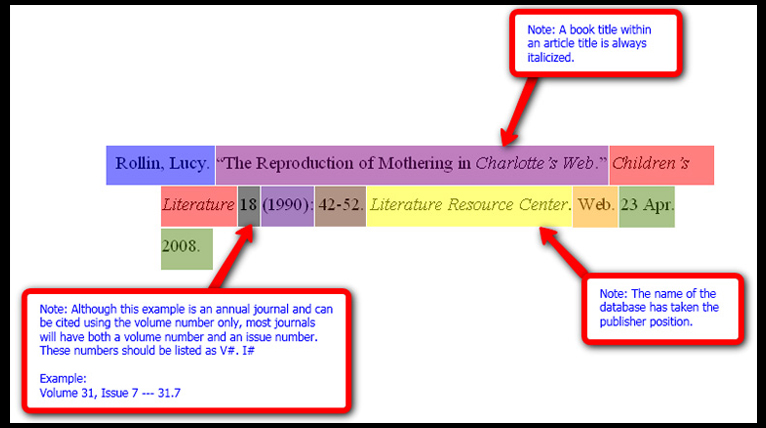
Contextual Study
Pictorialism Time Period: 1885 to 1915 Key Characteristics/Conventions: Pictorialism wished to approach photography like a painting, where the images taken resemble brush strokes etc rather than a photo. The style places beauty, tonality and composition above anything else when creating an accurate visual record. They wanted to move photography away from scientific uses and instead to artistic ideologies, to do this they took inspiration from certain artworks from which they adapted the style it was painted and composed in. Pictorialists were the first photographers to have their workrecognized as a form of art, committing their lives to photographic manipulation exploration, leading many to find new techniques not previously used or seen before. Artists Associated: Henry Peach Robinson, Julia Margaret Cameron, Peter Henry Emerson, The Vienna Camera Clud (Group), The Brotherhood of the Linked Ring (Group), Photo-Secession (Group). Key Works: Morning (1908 - Clarence H.White), Pond in Winter (1888, Peter Henry Emerson), I wait (1972, Rachel Gurney), The Steerage (1907, Alfred Stieglitz). Methods/Techniques/Processes: The style of work was created by manipulating images in the darkroom, scratching and marking their prints so that they imitate the texture of a canvas, using soft focus, blurred and fuzzy imagery based on allegorical and spiritual subject matter, including religious scenes.
Realism/Straight Photography Time Period: 1910 to present day Key Characteristics/Conventions: Straight photography emphasizes and engages the camera's own technical capability to produce images sharp and in focus with lots of detail. The photographers wished to makes images that were more 'photographic' rather than 'painterly', not wanting to treat photography as some monochrome painting. It is a process of time and represents immediacy, the passing time in history or the freezing of time in a snapshot, quoted by Henri Cartier-Bresson as "we work in unison with movement as though it were a presentiment on the way in which life itself unfolds. But inside movement there is one moment in which the elements in motion are in balance".Artists Associated: Alfred Stieglitz, Paul Strand, Walker Evans, Lewis W Hine, Jacob Riis, Dorothea Lange, Ansel Adams. Key Works: Porch Shadows (1916, Paul Strand), Blind Woman New York (1916, Paul Strand), The Tetons and the Snake River (1942, Ansel Adams). Methods/Techniques/Processes: The process is generally not manipulated but instead sharply depicts the image as someone sees it. Straight photographers visualize the image before taking it, stated by Ansel Adams "Get your lighting and exposure correct at the start and both the developing and printing can be practically automatic".
Double Exposure Transparency Experimentation
Using some of the images I have produced so far I have experimented with them using blending exposures. I believe that the outcomes of this experimentation have so far been aesthetically successful and give the images an abstract and unusual look, which would lead a viewer to question the strange composure and subjects within each of the images. For these experimentation I have used images from all three subject matters which i have focused on photographing. Using these three subjects together in single images will help to explore the links between these themes within surveillance. I believe that intertwining these subjects using double exposures and blending is a way of visually representing the similarities between different aspects of surveillance and how they work hand in hand, to create forces of mass surveillance.
Here are some examples of the blending experimentations which I have been working on so far…
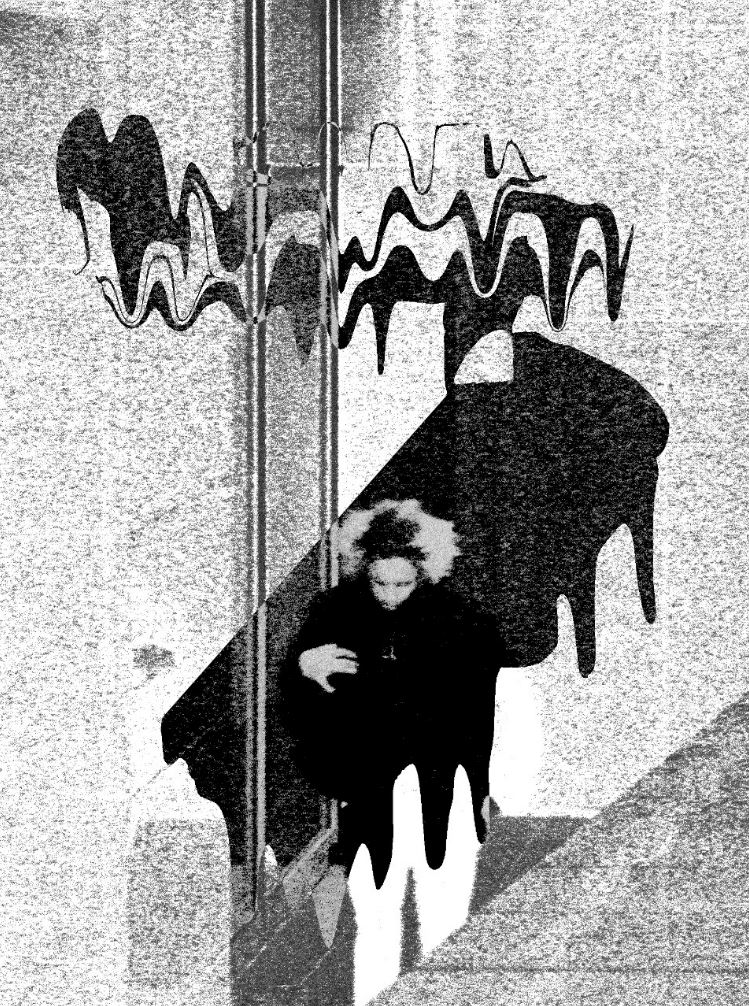

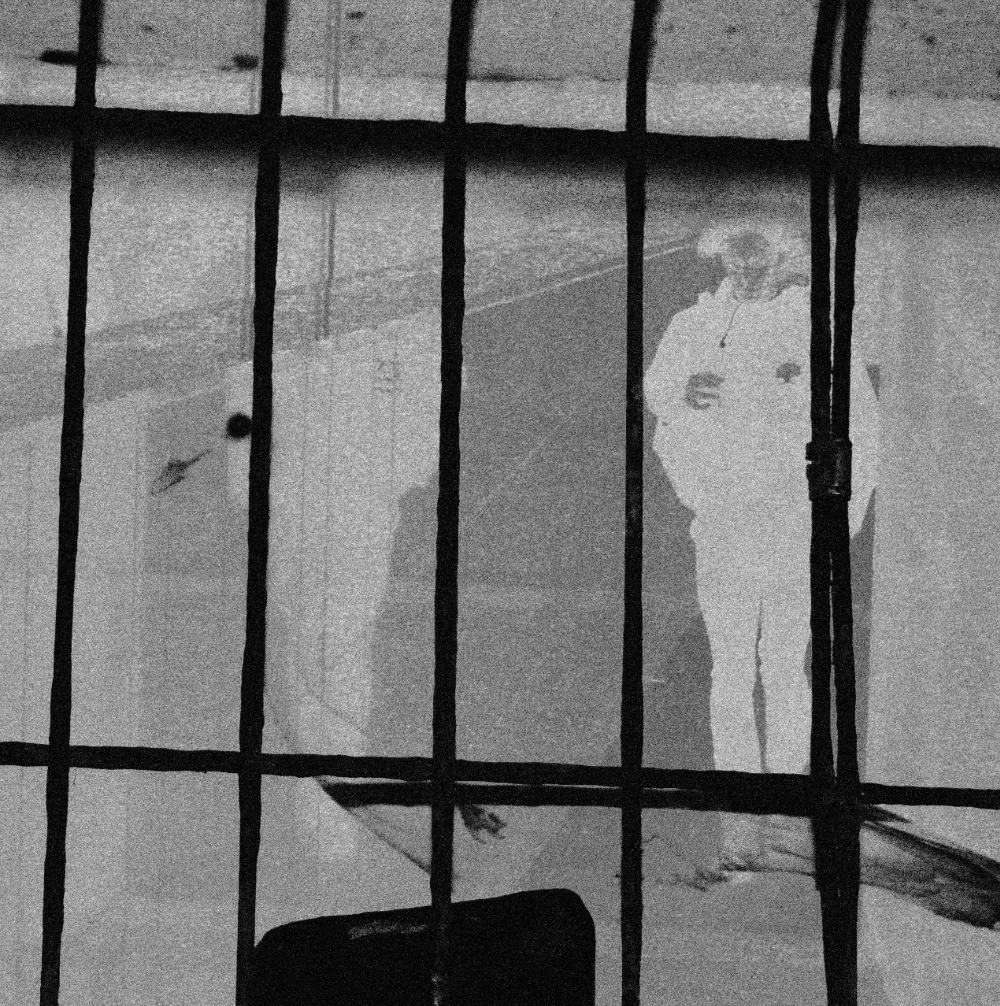
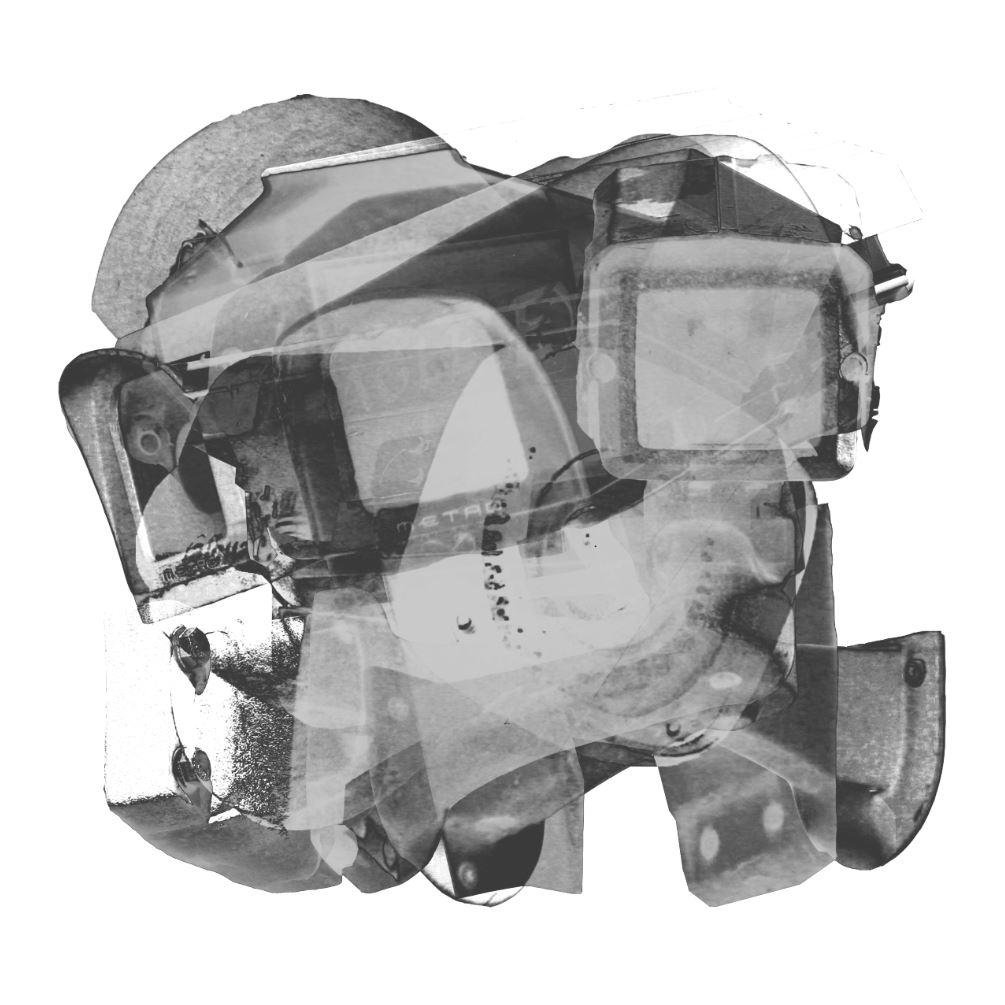
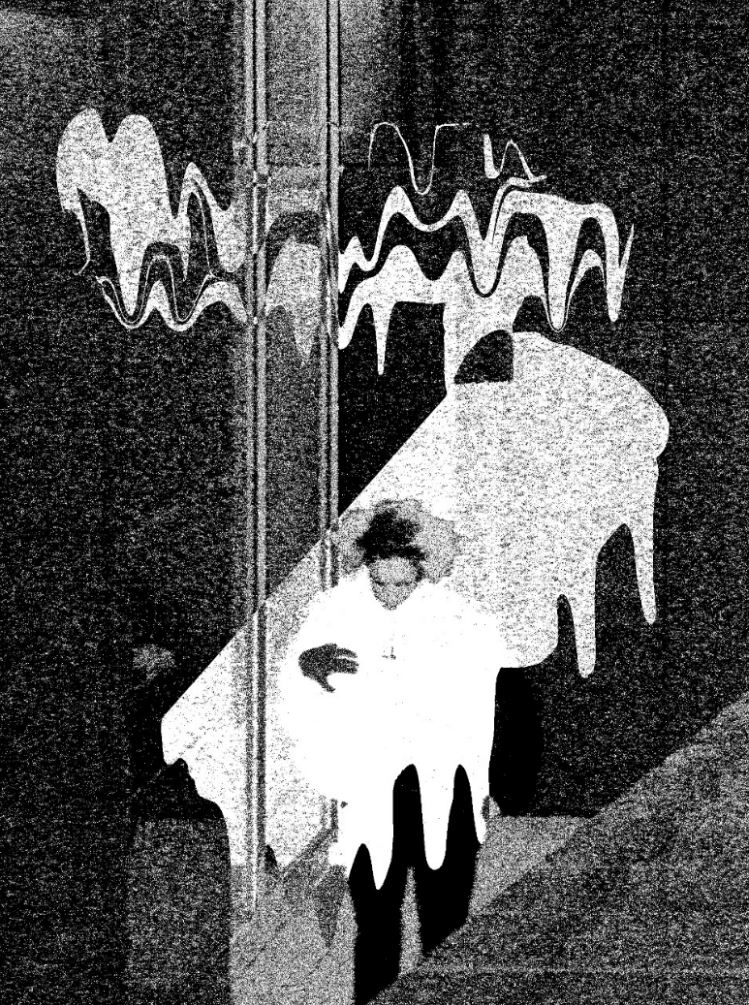
So far from what I have produced using this technique I am satisfied and therefore intend to continue producing work for this project in the same or similar ways.
Reviewing and Reflecting
Lesson 1 – Reviewing and reflecting:
Objective: Criteria from the Syllabus
- Write an overview from my personal investigation about what I’ve learned and how I intend to develop it.
- I will be describing the themes, artists, approaches, skills and photographic process/techniques that have inspired me the most and why.
Regarding my personal investigations I intend to approach it by using and exploring various techniques but a continuous style, examples consist of documentary and abstract to allow me to produce the results I desired. The themes I found to be the most interesting were the ones concerning consumerism and its effect on Jersey's landscape, I found that this allowed for a new insight into what happens with out waste and how much it affects the environment around it. From this it would allow me to give viewers a different perspective into what the outcome of our consumerism is, using software such as Photoshop and Lightroom to highlight specific details that I want to be focused on. Because of this I am able to portray each image differently from the next, as yes they all have a theme in common, but rather each explore a different aspect of consumerism and its impact. Two photographers who to me are particularly inspiring are Henry J Fair, someone who uses abstract imagery to capture the pollution of the world in aesthetic and stunning ways, and Edward Burtynsky, a photographer who captures the hidden beauty in consumerism, but also highlights the impact and devastation it causes on the environment. Both photographers use of vivid and harsh lighting accompanied by high saturation create landscapes that seem to surreal to be an actual place, drawing in my interest from how I loved the idea of using lighting as a conventional way in which photos are presented. I found that it would be most effective in end result areas of consumerism, as by portraying these dumping grounds in specific ways I believe that it would bring otherwise ugly imagery to life.
Harvard System Of Referencing
Book: Night walk – Ken Schles
…Which is the point that… makes when he says ‘Where once the journey was open-ended and uncertain, it now leads to an inevitable end’ (Schles 2014: 6)
Bibliography:
Schles, K. (2014), Night Walk. Germany: Steidl
Internet:
O’hagan, S (28 oct, 2015), *title* London : The Guardian (URL)
